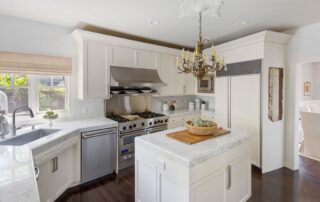How to Protect Your Deck and Fence Paint from Wear and Tear in California Weather
California’s diverse climate offers stunning outdoor scenery and year-round sunshine, making it an ideal place for homeowners to enjoy decks and fences. However, the same weather conditions that make California so appealing can also accelerate wear and tear on outdoor painted surfaces. From intense sun exposure and dry heat [...]
Not Sure When to Update Kitchen Cabinets? Read This First
Thinking about giving your kitchen a fresh look but not sure where to start? Calling in professional cabinet painters might be the easiest first step, especially if your cabinets are showing signs of age. In fact, knowing when to update kitchen cabinets can help you avoid a costly renovation [...]
Low-VOC Paints for Offices: Healthier Walls, Happier Employees
Creating a healthier work environment doesn’t have to be complicated. In fact, something as simple as choosing low-VOC paints for offices can have a major impact. For companies working with interior commercial painters, this choice can mean better air quality, improved employee wellness, and even stronger brand reputation. Let’s [...]
Want Long-Lasting Results? Here’s How to Prepare a Building for Painting
Getting ready for exterior commercial painting isn’t just about picking a color. It's about preparation. And knowing how to prepare a building for painting can save you money, reduce downtime, and make sure the finished job looks amazing and lasts longer. As a business owner, you want your property [...]
How to Choose the Best Color for Deck Paint or Stain
Choosing the best color for deck surfaces can feel overwhelming. Between design trends, climate concerns, and personal taste, it's hard to know what truly works. Many homeowners want to make the right choice, and they're turning to guidance from professional deck painters to help them figure it out. So, [...]
Avoid the Chaos: Mess-Free Fence Painting Tips That Work
Painting a fence may seem like a straightforward weekend project, but without the right approach, it can quickly turn into a messy, frustrating experience. That's why many homeowners end up calling in professional fence painters. But if you’re determined to do it yourself and want to keep things clean, [...]
Looking for the Best Primer for Interior Walls? Start Here!
If you're gearing up to paint your home, you've probably typed "best primer for interior walls" into your search bar more than once. And if you're like most homeowners, you've also asked around about reliable interior house painters to get the job done right. Let’s break it down in [...]
Fresh Paint, Fresh Sleep: Is It Safe to Sleep in a Freshly Painted Room?
If you’ve just finished some interior house painting, you might be wondering: is it safe to sleep in a freshly painted room? It seems like a simple question, but the answer depends on a few important factors. Knowing when it’s safe can help protect your health, improve sleep quality, [...]
The Ultimate Homeowner’s Guide: Cleaning Tips for Painted Cabinets
If you’ve recently invested in cabinet painting or are maintaining older painted surfaces, keeping them clean is essential. In this guide, we’ll walk you through straightforward, effective cleaning tips for painted cabinets that will help preserve their beauty and extend their lifespan. Painted cabinets add style and charm to [...]
How to Make Cabinet Paint Last: Tips Every Homeowner Needs
If you've ever finished a cabinet painting project only to watch the paint peel, chip, or fade within months, it's a frustrating outcome that's more common than you'd think. Many homeowners wonder how to make cabinet paint last and avoid the frustration of a finish that doesn't hold up. [...]














